SUBARU BRZ 2017 1.G Owners Manual
Manufacturer: SUBARU, Model Year: 2017, Model line: BRZ, Model: SUBARU BRZ 2017 1.GPages: 540, PDF Size: 6.88 MB
Page 451 of 540
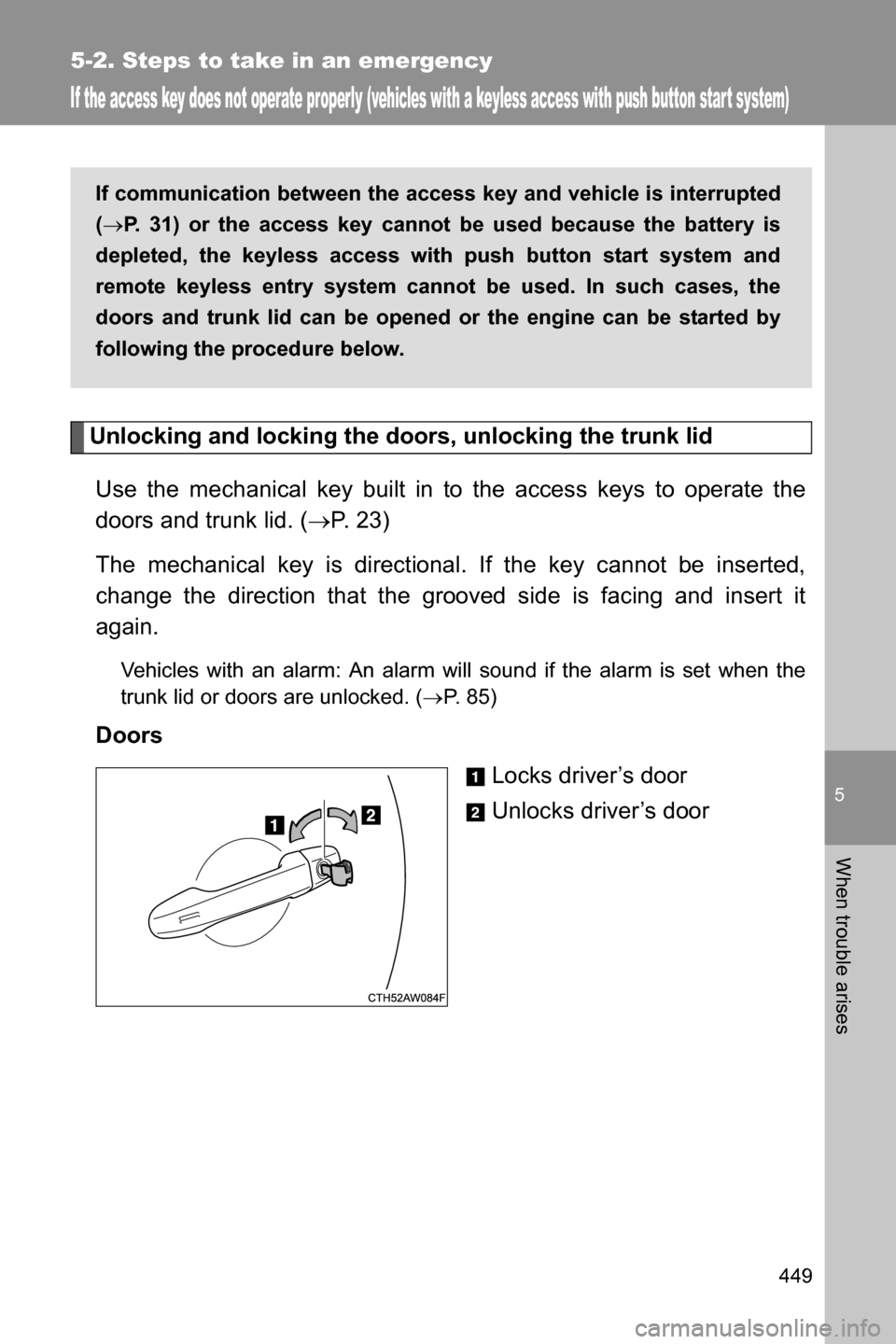
5
When trouble arises
449
5-2. Steps to take in an emergency
If the access key does not operate properly (vehicles with a keyless access with push button star t system)
Unlocking and locking the doors, unlocking the trunk lid
Use the mechanical key built in to the access keys to operate the
doors and trunk lid. (�oP. 2 3 )
The mechanical key is directional. If the key cannot be inserted,
change the direction that the grooved side is facing and insert it
again.
Vehicles with an alarm: An alarm will sound if the alarm is set when the
trunk lid or doors are unlocked. (�oP. 85)
Doors
Locks driver’s door
Unlocks driver’s door
If communication between the access key and vehicle is interrupted
(�oP. 31) or the access key cannot be used because the battery is
depleted, the keyless access with push button start system and
remote keyless entry system cannot be used. In such cases, the
doors and trunk lid can be opened or the engine can be started by
following the procedure below.
Page 452 of 540
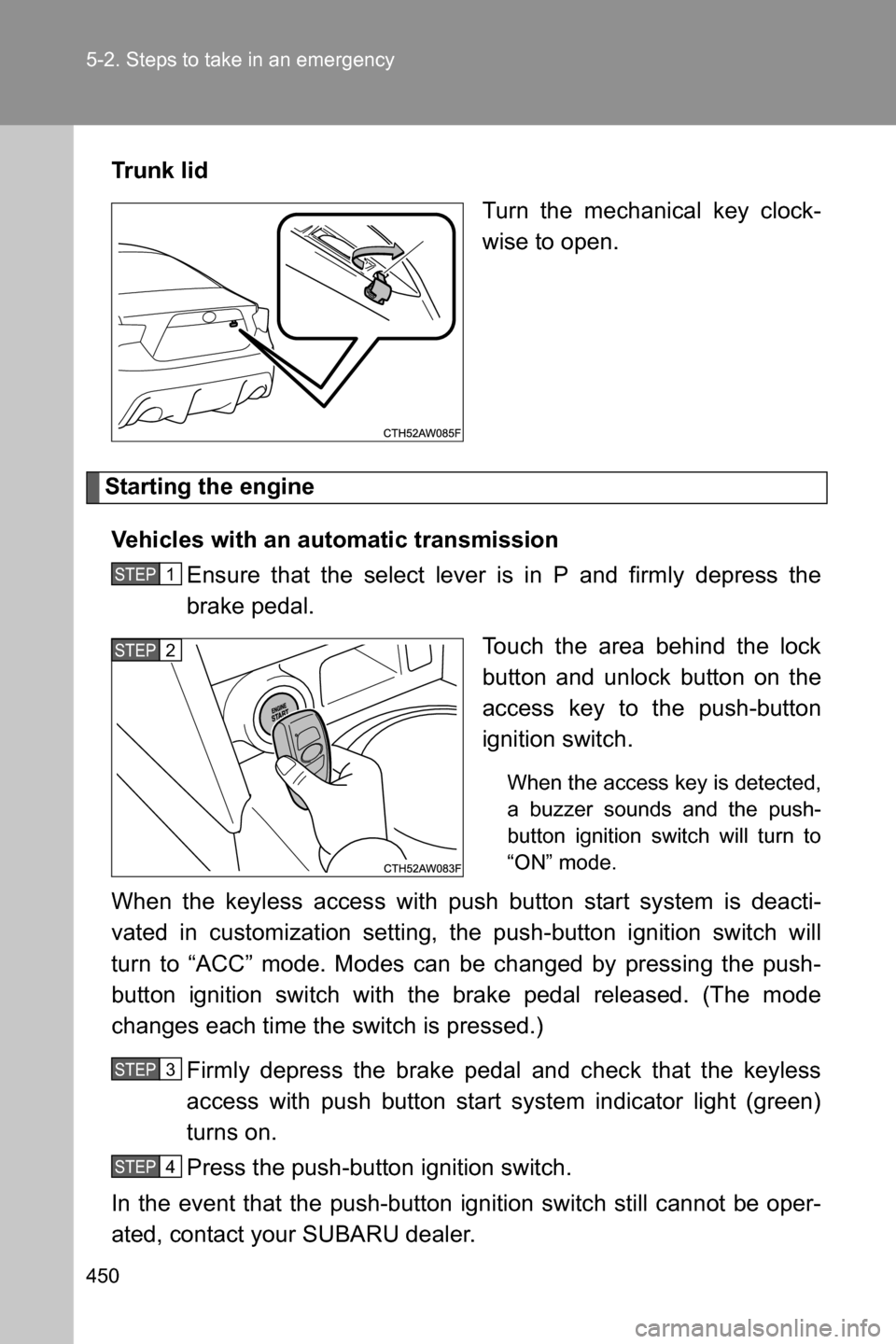
450 5-2. Steps to take in an emergency
Trunk lid
Turn the mechanical key clock-
wise to open.
Starting the engine
Vehicles with an automatic transmission
Ensure that the select lever is in P and firmly depress the
brake pedal.
Touch the area behind the lock
button and unlock button on the
access key to the push-button
ignition switch.
When the access key is detected,
a buzzer sounds and the push-
button ignition switch will turn to
“ON” mode.
When the keyless access with push button start system is deacti-
vated in customization setting, the push-button ignition switch will
turn to “ACC” mode. Modes can be changed by pressing the push-
button ignition switch with the brake pedal released. (The mode
changes each time the switch is pressed.)
Firmly depress the brake pedal and check that the keyless
access with push button start system indicator light (green)
turns on.
Press the push-button ignition switch.
In the event that the push-button ignition switch still cannot be oper-
ated, contact your SUBARU dealer.
STEP 1
STEP 2
STEP 3
STEP 4
Page 453 of 540
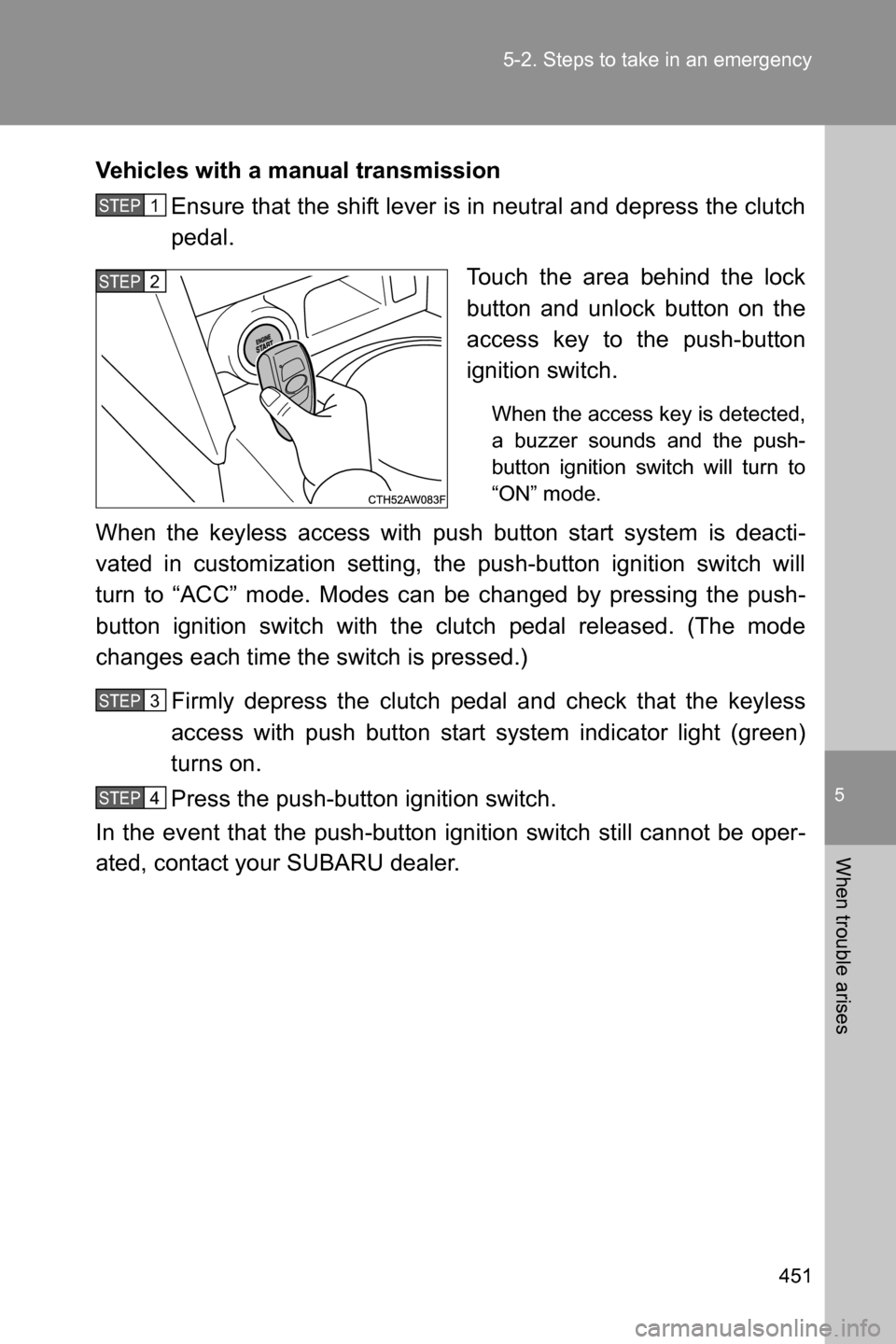
5
When trouble arises
451 5-2. Steps to take in an emergency
Vehicles with a manual transmission
Ensure that the shift lever is in neutral and depress the clutch
pedal.
Touch the area behind the lock
button and unlock button on the
access key to the push-button
ignition switch.
When the access key is detected,
a buzzer sounds and the push-
button ignition switch will turn to
“ON” mode.
When the keyless access with push button start system is deacti-
vated in customization setting, the push-button ignition switch will
turn to “ACC” mode. Modes can be changed by pressing the push-
button ignition switch with the clutch pedal released. (The mode
changes each time the switch is pressed.)
Firmly depress the clutch pedal and check that the keyless
access with push button start system indicator light (green)
turns on.
Press the push-button ignition switch.
In the event that the push-button ignition switch still cannot be oper-
ated, contact your SUBARU dealer.
STEP 1
STEP 2
STEP 3
STEP 4
Page 454 of 540
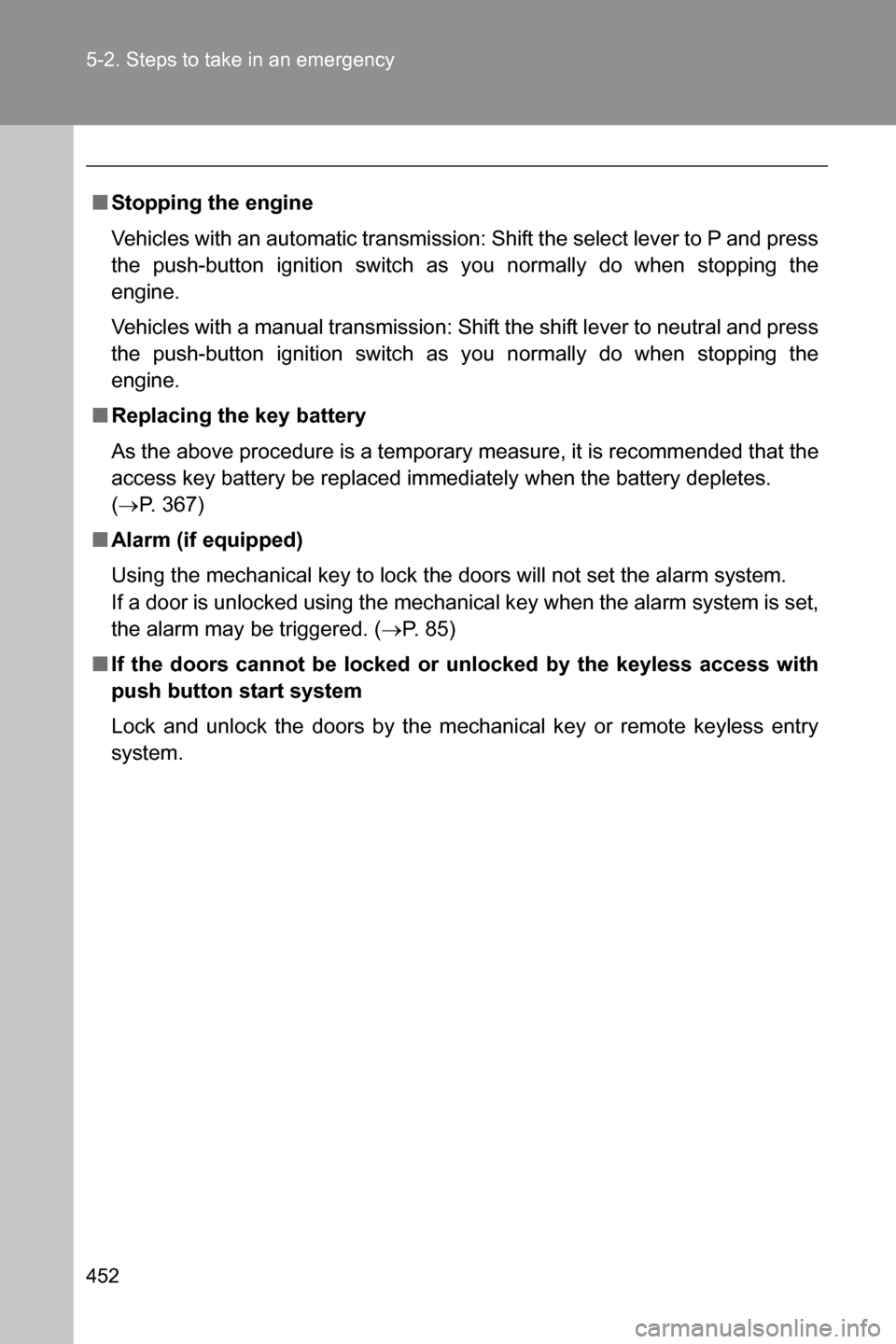
452 5-2. Steps to take in an emergency
■Stopping the engine
Vehicles with an automatic transmission: Shift the select lever to P and press
the push-button ignition switch as you normally do when stopping the
engine.
Vehicles with a manual transmission: Shift the shift lever to neutral and press
the push-button ignition switch as you normally do when stopping the
engine.
■Replacing the key battery
As the above procedure is a temporary measure, it is recommended that the
access key battery be replaced immediately when the battery depletes.
(�oP. 367)
■Alarm (if equipped)
Using the mechanical key to lock the doors will not set the alarm system.
If a door is unlocked using the mechanical key when the alarm system is set,
the alarm may be triggered. (�oP. 85)
■If the doors cannot be locked or unlocked by the keyless access with
push button start system
Lock and unlock the doors by the mechanical key or remote keyless entry
system.
Page 455 of 540
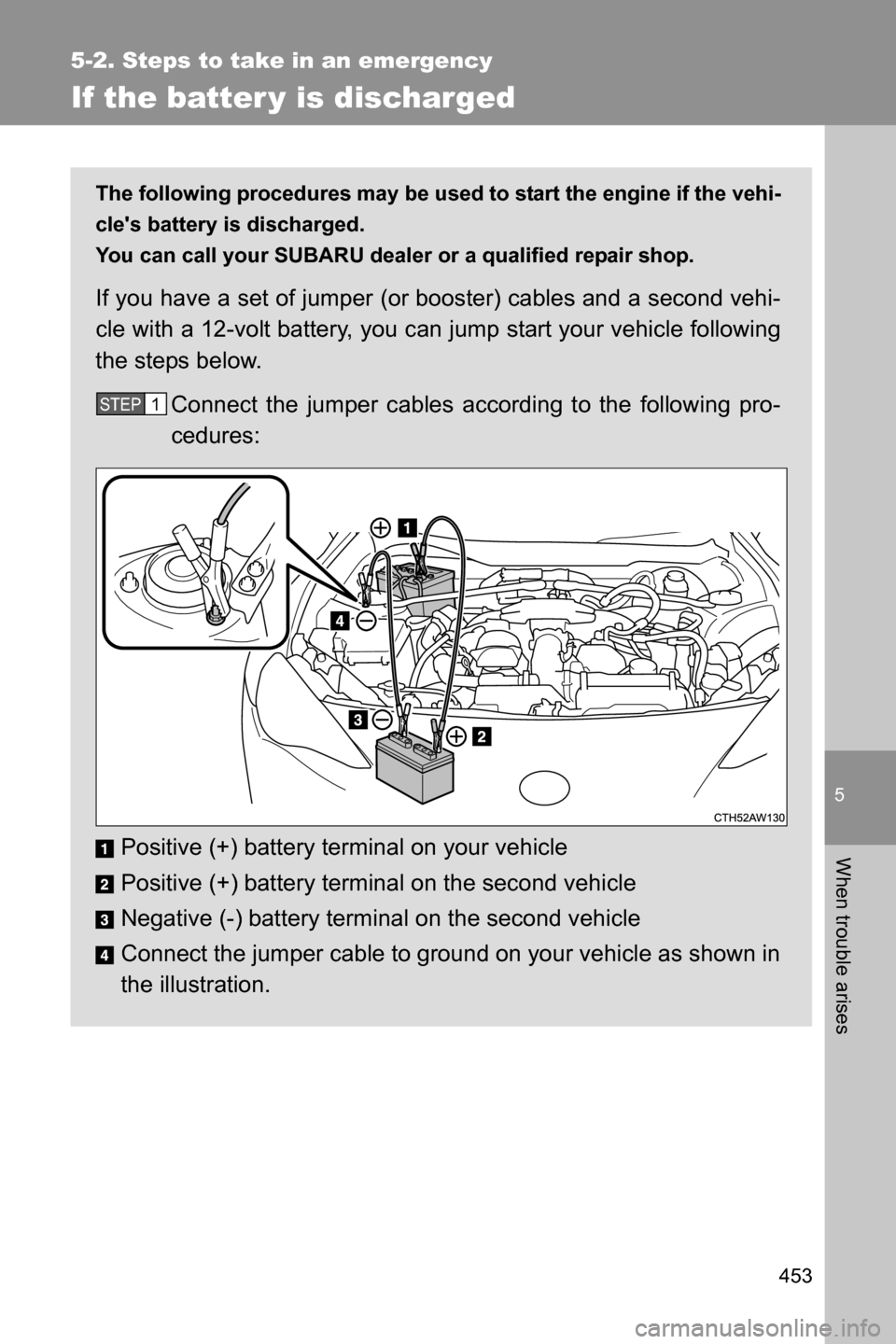
5
When trouble arises
453
5-2. Steps to take in an emergency
If the batter y is discharged
The following procedures may be used to start the engine if the vehi-
cle's battery is discharged.
You can call your SUBARU dealer or a qualified repair shop.
If you have a set of jumper (or booster) cables and a second vehi-
cle with a 12-volt battery, you can jump start your vehicle following
the steps below.
Connect the jumper cables according to the following pro-
cedures:
Positive (+) battery terminal on your vehicle
Positive (+) battery terminal on the second vehicle
Negative (-) battery terminal on the second vehicle
Connect the jumper cable to ground on your vehicle as shown in
the illustration.
STEP 1
Page 456 of 540
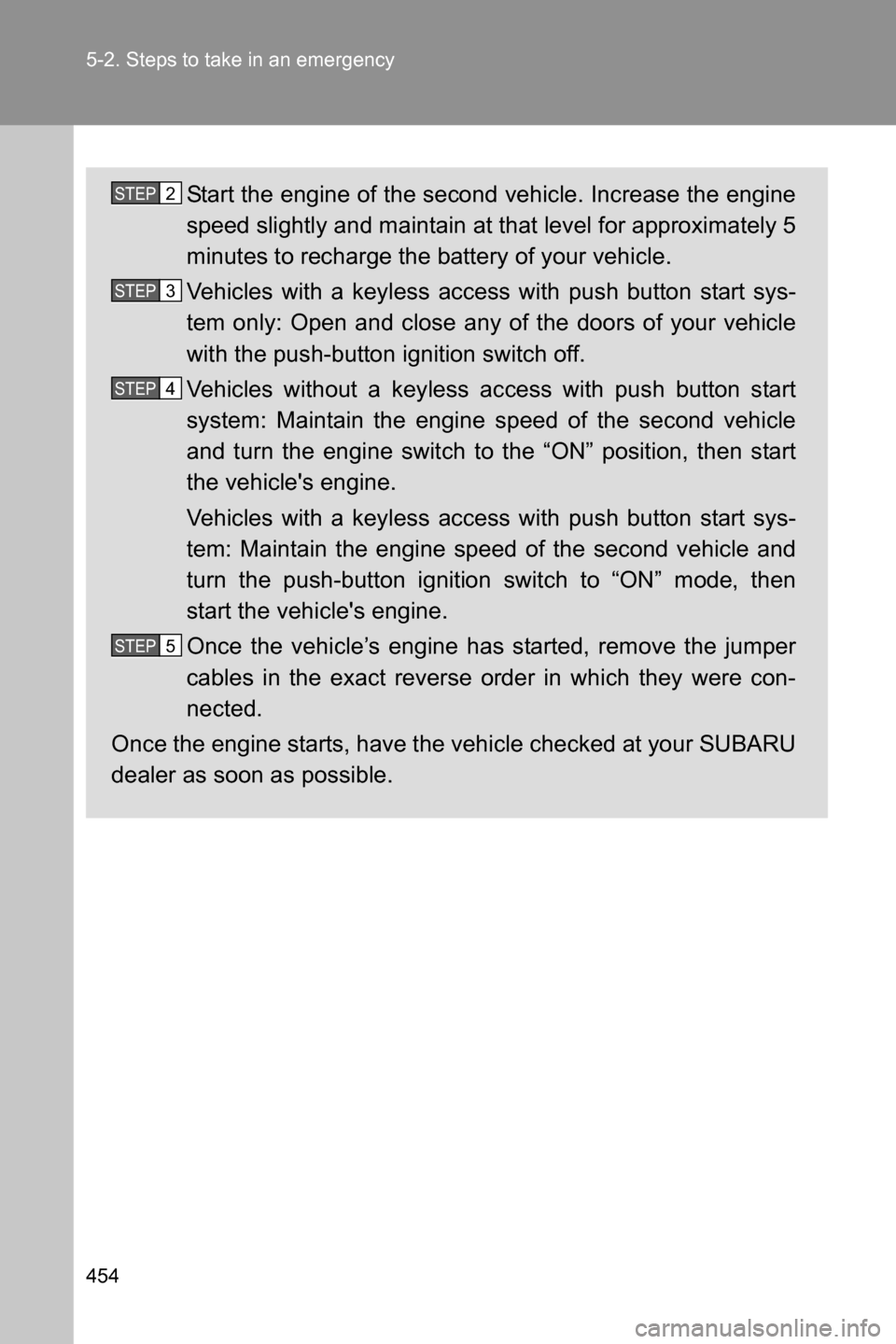
454 5-2. Steps to take in an emergency
Start the engine of the second vehicle. Increase the engine
speed slightly and maintain at that level for approximately 5
minutes to recharge the battery of your vehicle.
Vehicles with a keyless access with push button start sys-
tem only: Open and close any of the doors of your vehicle
with the push-button ignition switch off.
Vehicles without a keyless access with push button start
system: Maintain the engine speed of the second vehicle
and turn the engine switch to the “ON” position, then start
the vehicle's engine.
Vehicles with a keyless access with push button start sys-
tem: Maintain the engine speed of the second vehicle and
turn the push-button ignition switch to “ON” mode, then
start the vehicle's engine.
Once the vehicle’s engine has started, remove the jumper
cables in the exact reverse order in which they were con-
nected.
Once the engine starts, have the vehicle checked at your SUBARU
dealer as soon as possible.STEP 2
STEP 3
STEP 4
STEP 5
Page 457 of 540
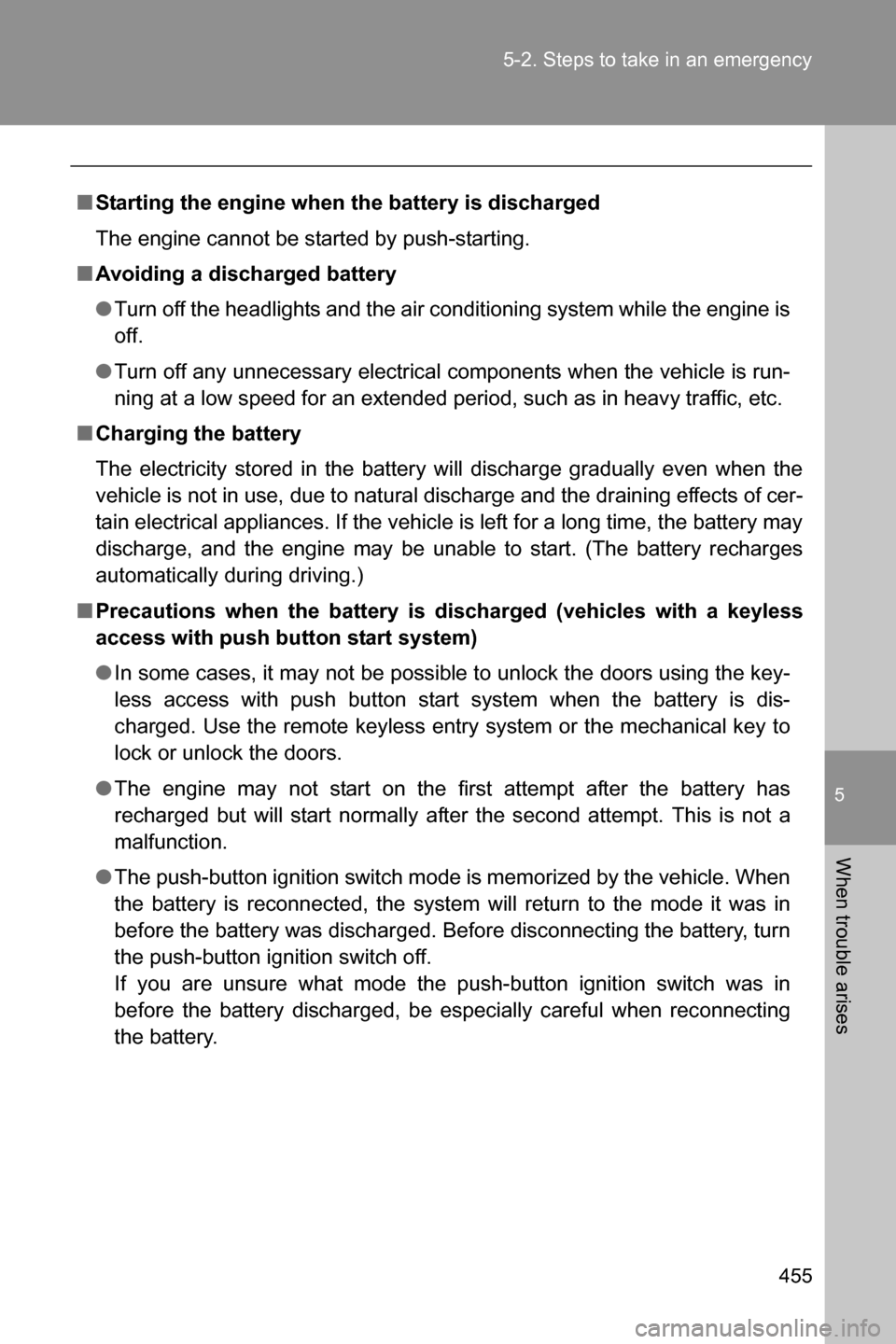
5
When trouble arises
455 5-2. Steps to take in an emergency
■Starting the engine when the battery is discharged
The engine cannot be started by push-starting.
■Avoiding a discharged battery
●Turn off the headlights and the air conditioning system while the engine is
off.
●Turn off any unnecessary electrical components when the vehicle is run-
ning at a low speed for an extended period, such as in heavy traffic, etc.
■Charging the battery
The electricity stored in the battery will discharge gradually even when the
vehicle is not in use, due to natural discharge and the draining effects of cer-
tain electrical appliances. If the vehicle is left for a long time, the battery may
discharge, and the engine may be unable to start. (The battery recharges
automatically during driving.)
■Precautions when the battery is discharged (vehicles with a keyless
access with push button start system)
●In some cases, it may not be possible to unlock the doors using the key-
less access with push button start system when the battery is dis-
charged. Use the remote keyless entry system or the mechanical key to
lock or unlock the doors.
●The engine may not start on the first attempt after the battery has
recharged but will start normally after the second attempt. This is not a
malfunction.
●The push-button ignition switch mode is memorized by the vehicle. When
the battery is reconnected, the system will return to the mode it was in
before the battery was discharged. Before disconnecting the battery, turn
the push-button ignition switch off.
If you are unsure what mode the push-button ignition switch was in
before the battery discharged, be especially careful when reconnecting
the battery.
Page 458 of 540
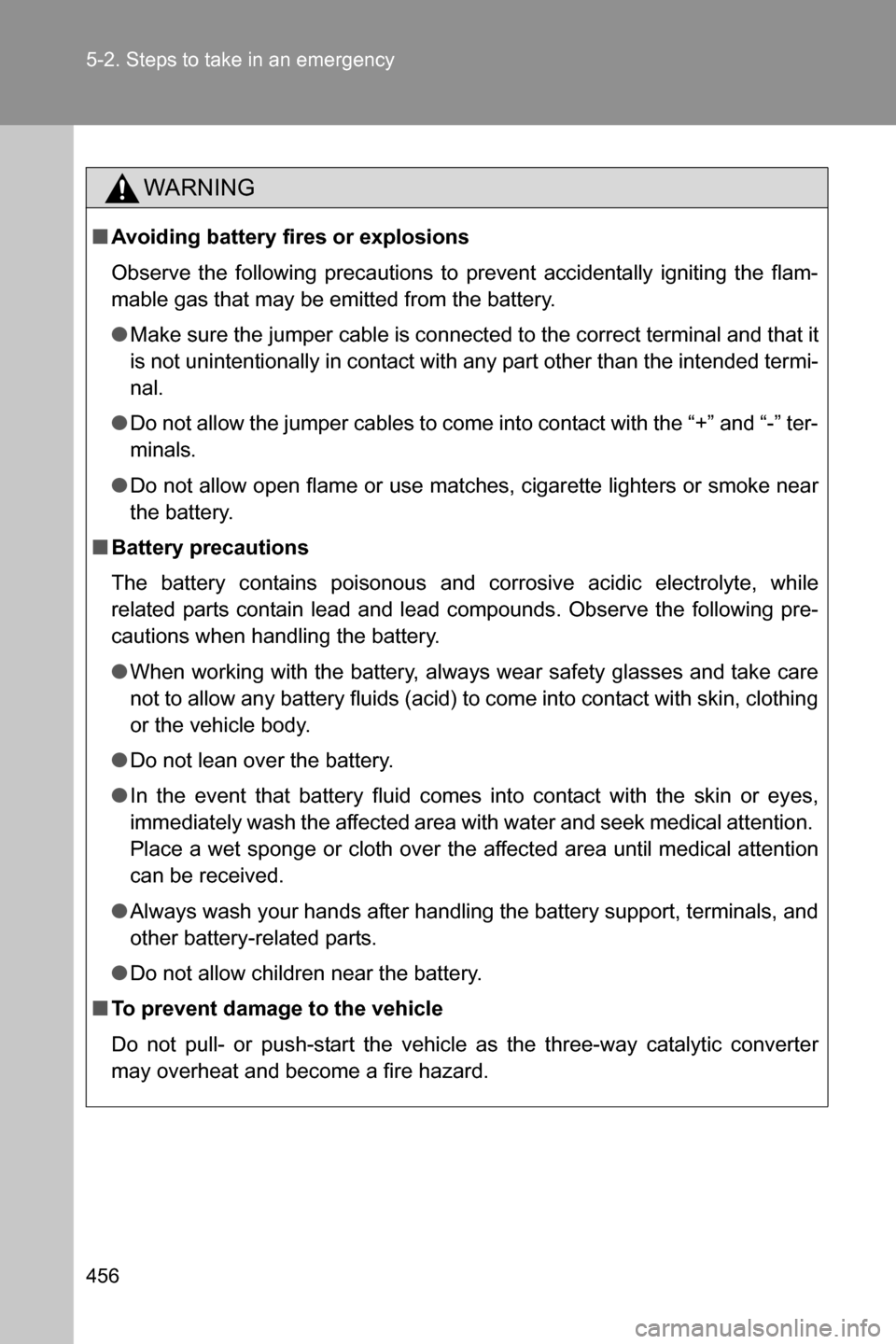
456 5-2. Steps to take in an emergency
WARNING
■Avoiding battery fires or explosions
Observe the following precautions to prevent accidentally igniting the flam-
mable gas that may be emitted from the battery.
●Make sure the jumper cable is connected to the correct terminal and that it
is not unintentionally in contact with any part other than the intended termi-
nal.
●Do not allow the jumper cables to come into contact with the “+” and “-” ter-
minals.
●Do not allow open flame or use matches, cigarette lighters or smoke near
the battery.
■Battery precautions
The battery contains poisonous and corrosive acidic electrolyte, while
related parts contain lead and lead compounds. Observe the following pre-
cautions when handling the battery.
●When working with the battery, always wear safety glasses and take care
not to allow any battery fluids (acid) to come into contact with skin, clothing
or the vehicle body.
●Do not lean over the battery.
●In the event that battery fluid comes into contact with the skin or eyes,
immediately wash the affected area with water and seek medical attention.
Place a wet sponge or cloth over the affected area until medical attention
can be received.
●Always wash your hands after handling the battery support, terminals, and
other battery-related parts.
●Do not allow children near the battery.
■To prevent damage to the vehicle
Do not pull- or push-start the vehicle as the three-way catalytic converter
may overheat and become a fire hazard.
Page 459 of 540
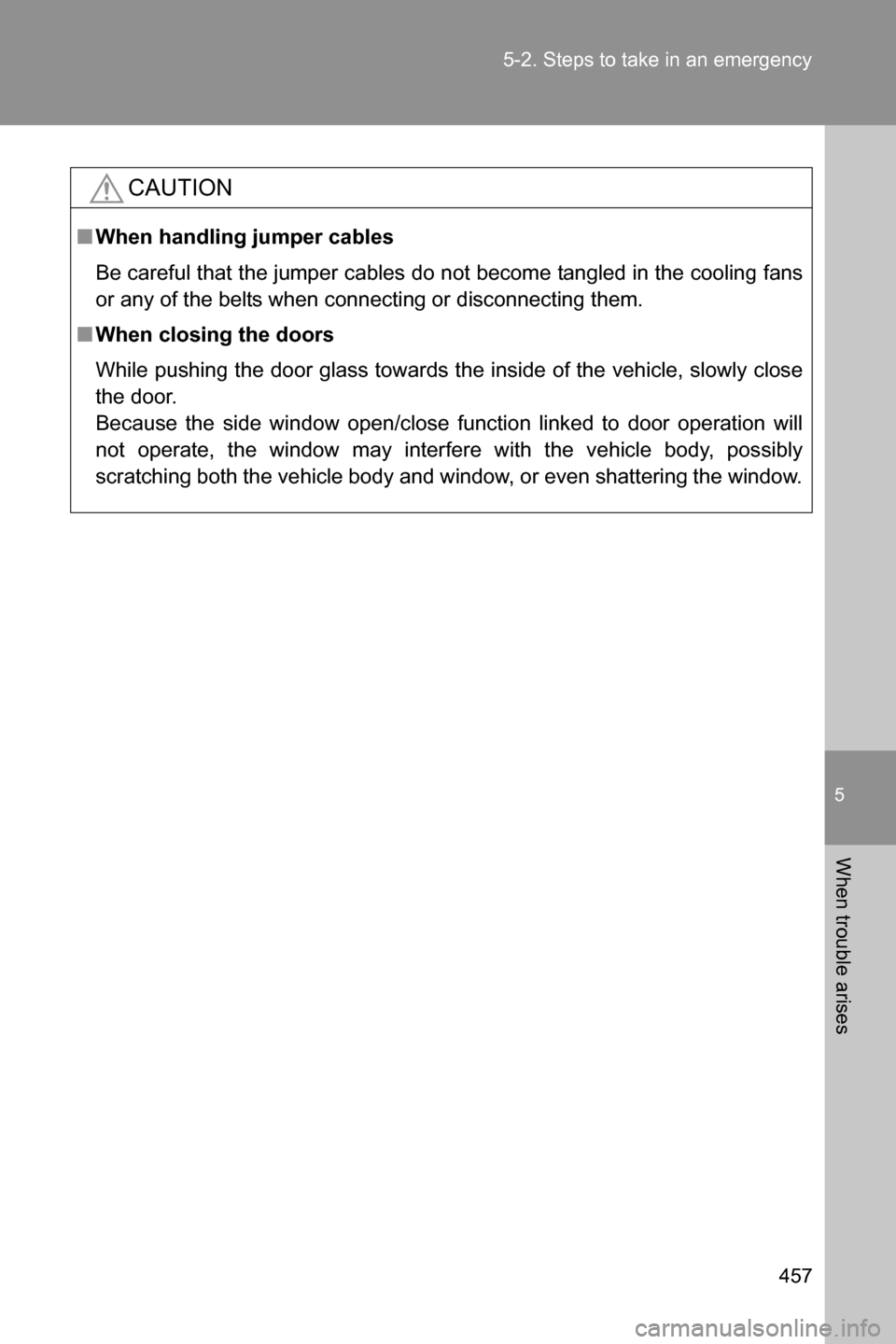
5
When trouble arises
457 5-2. Steps to take in an emergency
CAUTION
■When handling jumper cables
Be careful that the jumper cables do not become tangled in the cooling fans
or any of the belts when connecting or disconnecting them.
■When closing the doors
While pushing the door glass towards the inside of the vehicle, slowly close
the door.
Because the side window open/close function linked to door operation will
not operate, the window may interfere with the vehicle body, possibly
scratching both the vehicle body and window, or even shattering the window.
Page 460 of 540
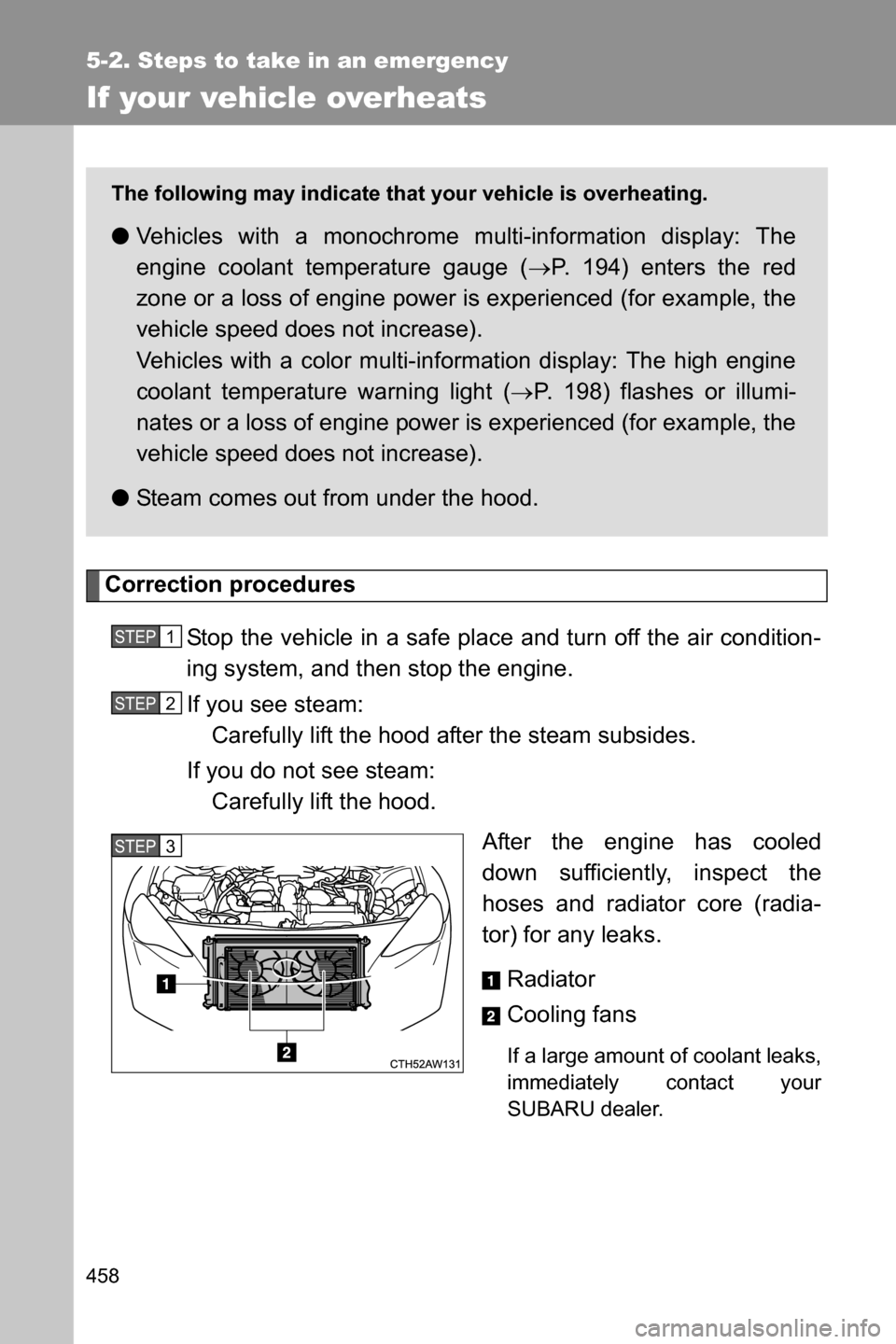
458
5-2. Steps to take in an emergency
If your vehicle overheats
Correction procedures
Stop the vehicle in a safe place and turn off the air condition-
ing system, and then stop the engine.
If you see steam:
Carefully lift the hood after the steam subsides.
If you do not see steam:
Carefully lift the hood.
After the engine has cooled
down sufficiently, inspect the
hoses and radiator core (radia-
tor) for any leaks.
Radiator
Cooling fans
If a large amount of coolant leaks,
immediately contact your
SUBARU dealer.
The following may indicate that your vehicle is overheating.
●Vehicles with a monochrome multi-information display: The
engine coolant temperature gauge (�oP. 194) enters the red
zone or a loss of engine power is experienced (for example, the
vehicle speed does not increase).
Vehicles with a color multi-information display: The high engine
coolant temperature warning light (�oP. 198) flashes or illumi-
nates or a loss of engine power is experienced (for example, the
vehicle speed does not increase).
●Steam comes out from under the hood.
STEP 1
STEP 2
STEP 3